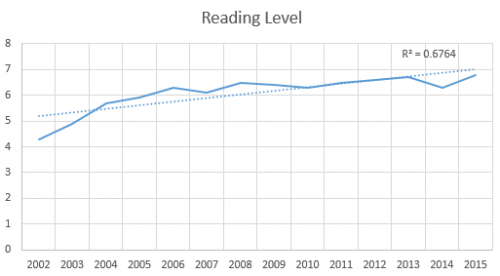This website has gone through a lot of iterations. This post runs through the history of the site, but basically it started in 1996 but really picked up in 2002 when I started blogging daily. I started by writing my own blog software, but eventually switched to Community Server. It was open source and I heavily modified it. Some time around 2008, Community Server ceased being free/open and became a paid product. I just keep chugging along with the software since it was working fine on my server.
Six years later, it still works fine, but I’ve been itching for a change. GoDaddy is ok but they feel increasingly scheevy. Because I no longer have updated versions of Community Server to play with, I’m stuck on old versions of IIS and SQL. Plus I’m missing out on lots of new features that modern content management systems offer. The biggest reason for a change is that GoDaddy limits me to 250MB in my SQL database. Long ago I hit that with the default setup and have had to clean out nearly everything except my posts (no search index, no statistics, etc.) I’m now on a collision course with an unmovable limit and would have no choice but to start deleting old posts.
So goodbye GoDaddy, hello Windows Azure! Azure is the Microsoft cloud platform. It’s an enormous amount of overkill for running a blog, but using it is a good educational process for my day job. WordPress is the state of the art blogging software these days and getting a WordPress website set up in Azure is less than a 5 minute process. It’s stupid simple. Congrats to the Azure team for a quality product.
Configuring WordPress obviously can take a lot longer because it’s dependent on what you want to accomplish. Over the 18 years of this website and 12 years of blogging, I’ve collected a lot of cruft. For the first time, I cut a bunch of it out and stuck to the core of what I think people use this site for: daily posts. The main change is that there are no more photo or video galleries. I’m also ditching my custom moblog and using Instagram instead. You’ll still be able to see the latest images when you come to my site though.
Surprisingly (to me), I’m still quite happy with my web site design. I kept a lot of the basic ideas in my move to WordPress/Azure but cleaned it up a lot. Mobile was also a key scenario. I used to operate a custom Windows Phone application called Pocket Ben. That will be decommissioned because you can just open my website in your mobile browser of choice and get a pretty good experience.
The second half of the move was all the backend server for CascadeSkier. The server does all the heavy lifting of collecting the various weather sensor information, forecasts and webcams. Then the apps all connect to that cached data for a speedy answer. I rearchitected some of that backend flow and also added a bunch of telemetry to the server pieces and the Windows Phone app. I can now get a much better idea of just how many people are using the app and what they are doing with it. The updates to the apps went out around Thanksgiving and I’ll be shutting down the old server at the end of 2014. If your CascadeSkier app stops working, you’re using an old version. You need to go to http://www.cascadeskier.com for more information.
I’m going to make the switchover on January 1. The main reason for that date is because I’m still doing the blog books and it’s easier for me if the switch doesn’t happen in the middle of a physical book. There might be a little downtime along the way as I change my domain names (or you might continue seeing this old site for a while.) To get a sneak peek at the new site, go to https://studio711.com. That’s a temporary URL until I point studio711.com to the new host. You don’t need to change any bookmarks. Also note that the new site doesn’t have all of the posts yet and is still changing on a pretty regular basis. Feel free to give me feedback.
Enjoy this site while you can. It’s days are numbered. On to bigger and better things! While you won’t notice a huge change as a reader, it’s a giant leap forward for me in terms of server technology and capabilities.




 A little over a month after moving to WordPress, I’m giving it a resounding two thumbs up. This is a huge upgrade over my ancient fork of the Community Server codebase. Here are a few things that I really enjoy:
A little over a month after moving to WordPress, I’m giving it a resounding two thumbs up. This is a huge upgrade over my ancient fork of the Community Server codebase. Here are a few things that I really enjoy: This is a geeky post but I feel the need to give back to the community and help others who might stumble on a similar issue. Regular readers can feel free to skip this. Tomorrow’s post will return to more normal topics.
This is a geeky post but I feel the need to give back to the community and help others who might stumble on a similar issue. Regular readers can feel free to skip this. Tomorrow’s post will return to more normal topics.

 This new website is hopefully pretty easy to get around, but there are a few things that I’d like to point out:
This new website is hopefully pretty easy to get around, but there are a few things that I’d like to point out: This is a personal blog and it’s almost entirely a hobby so it makes sense that I never ask for donations or show banner ads. That being said, it’s not free. I added an Amazon.com link to the right hand side of the page. If you are planning to buy something at Amazon, consider clicking
This is a personal blog and it’s almost entirely a hobby so it makes sense that I never ask for donations or show banner ads. That being said, it’s not free. I added an Amazon.com link to the right hand side of the page. If you are planning to buy something at Amazon, consider clicking  As I ponder moving all of my web stuff from GoDaddy to Azure, one of the big pieces is the backend infrastructure for the CascadeSkier line of apps. There is the Windows 7 gadget, Windows 8 modern app, and Windows Phone app, each with slightly different but mostly similar requirements.
As I ponder moving all of my web stuff from GoDaddy to Azure, one of the big pieces is the backend infrastructure for the CascadeSkier line of apps. There is the Windows 7 gadget, Windows 8 modern app, and Windows Phone app, each with slightly different but mostly similar requirements. Now that my job at work is 100% focused on running a product in the cloud, I’ve been spending some time at home playing around with Azure (Microsoft’s cloud offering) and wow is it impressive! I remember looking at it a couple years ago and just seeing a garbled mess that was impossible to decipher, but now it’s gotten ridiculously easy.
Now that my job at work is 100% focused on running a product in the cloud, I’ve been spending some time at home playing around with Azure (Microsoft’s cloud offering) and wow is it impressive! I remember looking at it a couple years ago and just seeing a garbled mess that was impossible to decipher, but now it’s gotten ridiculously easy.